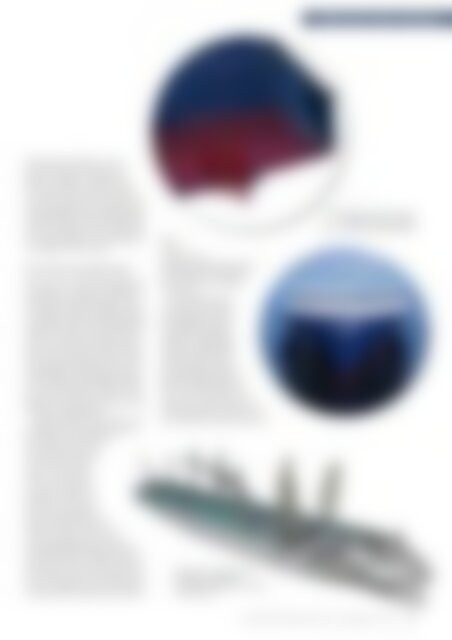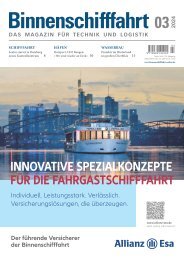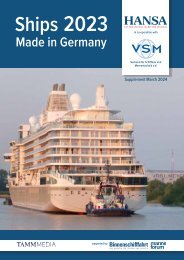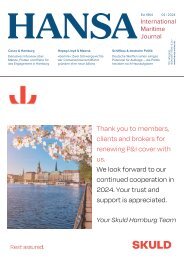HANSA 01-2019
Speditionen | Windantrieb | Tanker-Report | RAVE | Bilanz deutscher Häfen | Hyperloop | Fokus Bunker & Schmierstoffe | Shortsea | dship | Hansa Heavy Lift | Review HANSA-Forum
Speditionen | Windantrieb | Tanker-Report | RAVE | Bilanz deutscher Häfen | Hyperloop | Fokus Bunker & Schmierstoffe | Shortsea | dship | Hansa Heavy Lift | Review HANSA-Forum
Erfolgreiche ePaper selbst erstellen
Machen Sie aus Ihren PDF Publikationen ein blätterbares Flipbook mit unserer einzigartigen Google optimierten e-Paper Software.
Schiffstechnik | Ship Technology<br />
The design also utilizes an air-lubrication<br />
system. During sea navigation,<br />
air bubbles are delivered to<br />
the vessel bottom to reduce frictional<br />
resistance between the hull and the<br />
water. During port stays, automatic hull<br />
cleaning robots will clean the dirty hull<br />
to reduce resistance that could negatively<br />
affect vessel efficiency. These robots will<br />
also collect all debris to prevent pollution<br />
of ecological systems at port.<br />
Fuel cell and renewable energy<br />
The vessel is powered by hydrogen fuel<br />
cells (SOFC), in which the hydrogen is<br />
produced by renewable energy sources.<br />
According to NYK, the design has a power<br />
production efficiency of 69% through<br />
waste heat recovery. The hydrogen tank<br />
capacity of 1,900 m3 ensures a 21-day endurance.<br />
The storage of liquefied hydrogen<br />
on board the vessel will be expensive<br />
and require significant space, so fully<br />
utilizing power produced on board is essential.<br />
Therefore, the designers propose<br />
to use solar power allowing for an energy<br />
conversion efficiency of 45%. About<br />
9,000 m2 of solar panels will cover 15%<br />
of the total energy demand.<br />
Holistic Digital Twins of each vessel<br />
will enable access to shorebased expertise<br />
for the crew on board. Several<br />
scenarios can be evaluated<br />
to optimize planned<br />
and corrective maintenance<br />
to minimize accidents<br />
and troubles<br />
on board. Thanks to<br />
advanced weather and<br />
performance optimization,<br />
route planning is no<br />
longer a ship-level activity. It<br />
is done at the port and at fleet<br />
level, which enables just-in-time arrival<br />
throughout the supply chain. Simultaneous<br />
ship-to-berth and ship-toship<br />
cargo work will minimize port stay<br />
hours. Shorter port stays will allow for<br />
slower sea navigation and result in energy<br />
savings. Thanks to improvement of shore<br />
facilities,<br />
automatic<br />
mooring<br />
and berthing will be possible<br />
to minimize port stay hours.<br />
Shore power is also supplied<br />
to the vessel.<br />
In April 2009, NYK released<br />
the initial exploratory<br />
design for its Super<br />
Eco Ship 2030. This concept<br />
already included the<br />
utilization of lightweight<br />
materilas, optimized hull<br />
shape and other progressive<br />
technologies with potential<br />
of being realized by<br />
2030. The 2030 design featured<br />
LNG-based fuel cells,<br />
solar cells and wind power, all<br />
of which will lead to a reduction of<br />
CO2 by 69% per container carried. fs<br />
The Super Eco Ship 2030 already<br />
included other progressive<br />
technologies with potential of being<br />
realized by 2030<br />
Flapping foils mimic the movement<br />
of dolphins (above), pontoon<br />
stabilizers allow for an optimized hull<br />
<strong>HANSA</strong> International Maritime Journal – 156. Jahrgang – 2<strong>01</strong>9 – Nr. 1 61


















